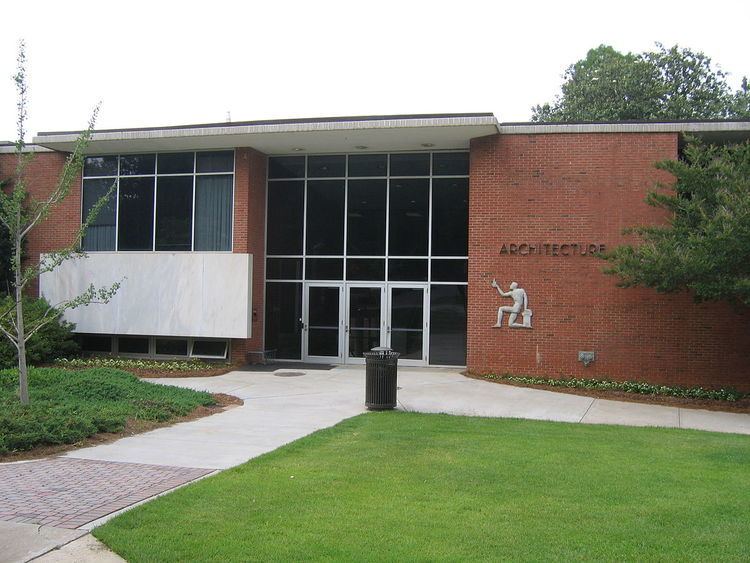Academic staff 252 Total enrollment 1,011 (2011) Founded 1908 Dean Alan Balfour | Established 1908 Postgraduates 523 Website design.gatech.edu Phone +1 404-894-3880 Undergraduates 574 | |
 | ||
Address 245 4th St NW, Atlanta, GA 30332, USA Parent organization Georgia Institute of Technology Notable alumni Similar Georgia Institute of Technology, Faculty of Architecture‑GBTU, University of Texas at Austin Sc, Commerce College - Jaipur, Southern Polytechnic State Uni Profiles | ||
The College of Design at the Georgia Institute of Technology was established in 1908 as the Department of Architecture, and formerly the College of Architecutre, offering the first four-year course of study in architecture in the Southern United States.
Contents
History
The history of the College of Design spans over 100 years. The Department of Architecture was formed in 1908, and granted its first degree in 1911. It was renamed to the School of Architecture after World War II, and elevated to a full-fledged College of Architecture in 1975. In 2016, it was renamed the College of Design in order to more accurately reflect the breadth of programs the College offers, and to reduce confusion between the College of Architecture and its component School of Architecture. For most of the 20th century, the Architecture curriculum was directed by masters of architecture, mostly Harvard graduates (until 1975).
In 1908, Georgia Tech (as the "Georgia School of Technology") formally began teaching architecture, when Preston A. Hopkins of Boston was appointed to teach the entering class of 20 students and organize the curriculum. The new Department of Architecture, although small, was equal in rank to other academic departments of engineering at Tech. Francis Palmer Smith (B.S. Univ. of Pennsylvania 1907) was selected as the first department head in 1909. In 1911, the first degrees, the Bachelor of Science in Architecture, were granted. This event placed Georgia Tech among the earliest public universities in the U. S. to offer an architecture degree. By 1912, the Department of Architecture grew to 42 full-time students with three faculty members.
By 1930, the Architecture department had 132 full-time students, awarded 20 degrees, and had six full-time with six part-time faculty. The curriculum during the early years was closely allied with engineering, plus the subject of construction was strongly emphasized. By the 1930s, the influence of the Beaux-Arts, formerly a dominant force in architectural education nationally, had begun to decline as the sway of Bauhaus increased. The department did not have the post-professional graduate program or an option for architectural engineering, both of which were contained in over half of the architecture schools at the time. Architectural education was mainly a product of local concerns in Atlanta, in Georgia and the South, in accordance with the mission of the Georgia School of Technology. In 1934, the five-year Bachelor of Architecture degree was created to conform with the requirements of the increasingly influential Association of Collegiate Schools of Architecture (ACSA). Under the leadership of Bush-Brown, the Architecture students declined to 66 during the depression, reached a low of 22 students during World War II, and then exploded to 462 post-war students.
In 1948, the new School of Architecture was formed and made parallel to other professional schools within the newly renamed Georgia Institute of Technology. In 1952, the School of Architecture building, designed by Bush-Brown, Gailey and Heffernan, was constructed, creating a separate identity for the school, with a highly professional curriculum. In 1975, the College of Architecture was formed to handle increased enrollment and strengthening of allied disciplines. William Fash (Oklahoma State University, M.ARCH, 1960) was appointed as first dean of Architecture in 1976. In 1975, with respect to its international thrust, the college's Paris Program was established by P. M. Heffernan. Originally located at the Ecole d'Architecture Paris Tolbiac and moved to the Ecole d'Architecture Paris la Villette, the Program provides for a full year of study for architecture students during their senior year of undergraduate study. In 1992, a Division of Fine Arts was created in the College of Architecture, leading to a new Arts and Technology Program for course work in the areas of music, visual arts, and multimedia.
In 1995, the Center for Geographic Information Systems (CGIS) was created. The CGIS has worked on projects for the 1999 Color Infra-Red (CIR) Digital Ortho Photo Program, for the Georgia GIS Data Clearinghouse, for the NWI-Wetlands statewide digital wetland database with GIS tools, for the Trees Atlanta-Greenspace Acquisition Support System, the U.S. Environmental Protection Agency-Air Quality, natural hazards, hydrography, and for infrastructure management.
Schools within the College of Design
Facilities
The College of Design occupies several buildings and spaces throughout campus, the center of which are the two main buildings- College of Architecture East and West- in the center of campus on Fourth Street.
Degrees
A complete list is available on the College of Design website.
